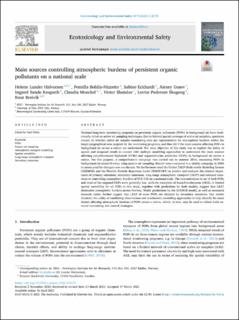| dc.contributor.author | Halvorsen, Helene Lunder | |
| dc.contributor.author | Bohlin-Nizzetto, Pernilla | |
| dc.contributor.author | Eckhardt, Sabine | |
| dc.contributor.author | Gusev, Alexey | |
| dc.contributor.author | Krogseth, Ingjerd Sunde | |
| dc.contributor.author | Möckel, Claudia | |
| dc.contributor.author | Shatalov, Victor | |
| dc.contributor.author | Skogeng, Lovise Pedersen | |
| dc.contributor.author | Breivik, Knut | |
| dc.date.accessioned | 2021-06-18T07:16:18Z | |
| dc.date.available | 2021-06-18T07:16:18Z | |
| dc.date.created | 2021-06-15T15:36:08Z | |
| dc.date.issued | 2021 | |
| dc.identifier.citation | Ecotoxicology and Environmental Safety. 2021, 217, 112172. | en_US |
| dc.identifier.issn | 0147-6513 | |
| dc.identifier.uri | https://hdl.handle.net/11250/2760043 | |
| dc.description.abstract | National long-term monitoring programs on persistent organic pollutants (POPs) in background air have traditionally relied on active air sampling techniques. Due to limited spatial coverage of active air samplers, questions remain (i) whether active air sampler monitoring sites are representative for atmospheric burdens within the larger geographical area targeted by the monitoring programs, and thus (ii) if the main sources affecting POPs in background air across a nation are understood. The main objective of this study was to explore the utility of spatial and temporal trends in concert with multiple modelling approaches to understand the main sources affecting polychlorinated biphenyls (PCBs) and organochlorine pesticides (OCPs) in background air across a nation. For this purpose, a comprehensive campaign was carried out in summer 2016, measuring POPs in background air across Norway using passive air sampling. Results were compared to a similar campaign in 2006 to assess possible changes over one decade. We furthermore used the Global EMEP Multi-media Modeling System (GLEMOS) and the Flexible Particle dispersion model (FLEXPART) to predict and evaluate the relative importance of primary emissions, secondary emissions, long-range atmospheric transport (LRAT) and national emissions in controlling atmospheric burdens of PCB-153 on a national scale. The concentrations in air of both PCBs and most of the targeted OCPs were generally low, with the exception of hexachlorobenzene (HCB). A limited spatial variability for all POPs in this study, together with predictions by both models, suggest that LRAT dominates atmospheric burdens across Norway. Model predictions by the GLEMOS model, as well as measured isomeric ratios, further suggest that LRAT of some POPs are dictated by secondary emissions. Our results illustrate the utility of combining observations and mechanistic modelling approaches to help identify the main factors affecting atmospheric burdens of POPs across a nation, which, in turn, may be used to inform both national monitoring and control strategies. | en_US |
| dc.language.iso | eng | en_US |
| dc.rights | Navngivelse 4.0 Internasjonal | * |
| dc.rights.uri | http://creativecommons.org/licenses/by/4.0/deed.no | * |
| dc.title | Main sources controlling atmospheric burdens of persistent organic pollutants on a national scale | en_US |
| dc.type | Peer reviewed | en_US |
| dc.type | Journal article | en_US |
| dc.description.version | publishedVersion | en_US |
| dc.rights.holder | © 2021 The Author(s). Published by Elsevier Inc. | en_US |
| dc.source.volume | 217 | en_US |
| dc.source.journal | Ecotoxicology and Environmental Safety | en_US |
| dc.identifier.doi | 10.1016/j.ecoenv.2021.112172 | |
| dc.identifier.cristin | 1915953 | |
| dc.relation.project | Norges forskningsråd: 244298 | en_US |
| dc.relation.project | Framsenteret: Flagship "Hazardous substances" | en_US |
| dc.relation.project | NILU - Norsk institutt for luftforskning: 115027 | en_US |
| dc.source.articlenumber | 112172 | en_US |
| cristin.ispublished | true | |
| cristin.fulltext | original | |
| cristin.qualitycode | 2 | |

